Recently, I was thinking why there are more famous Master Chefs in the world than there are Master Bakers. A Michelin-starred restaurant cannot have poor quality bread to be earning a Michelin star. No way. But the issue here for me is: Can bread be a stand-alone meal, complete in all its nutrition, but more importantly, in its artistry and flair, technique, and satisfaction, such that once you have it, your body and mind do not desire other food?
Recently, also, with my post of the apple and molasses Swedish Rye Bread here at TFL and Sourdough Companion, Maedi of Sourdough Companion and I were exchanging views regarding ying and yang of bread. In his view, ying and yang is manifested in each loaf we made either at the bread level or at how we enjoy the bread (with a topping on it, or with a meal or soup, etc.). When it is at the bread level, this could include building unique ingredients into the bread to create interesting flavours and textures. I said that, however, many experienced sourdough bakers seem to go for the "pure" flavor of flour in bread and, therefore, would play with fermentation potentials in flour rather than with the combination possibilities of non-flour ingredients. On page 145 of Bread, Master Baker Hamelman notes, "... it is my hope that every baker will learn the subtle art of fermentation - the truest skill of the baker - before exploring bread formulas whose ingredients mask the taste of fermented flour."
I don't intend to make a bigger discussion here than I am capable of. I can only say that, purist or not, I find both ideas attractive; ie, the idea of trying to let the true flavour of flour shine and the idea of building interesting ingredients into the bread for extra textures and flavours. This bread is my attempt on both front (fronts?). So, thank you, Maedi, for your thoughts and for crystalising my thoughts for me.
I wish my daughter were here to read my draft and help me out with whatever needs to be corrected with my grammar and sentences. She is only gone for a few days but I am already missing her. The very loud music of Van Morrison streams out of my tea room as I write. The music energizes me. I am in love with it and I can feel my heart throbbing, almost painful. My daughter would enjoy this music too. The boys are playing golf today. When they return, they will bring me fish for dinner tonight, as they always do.
Here is this bread:
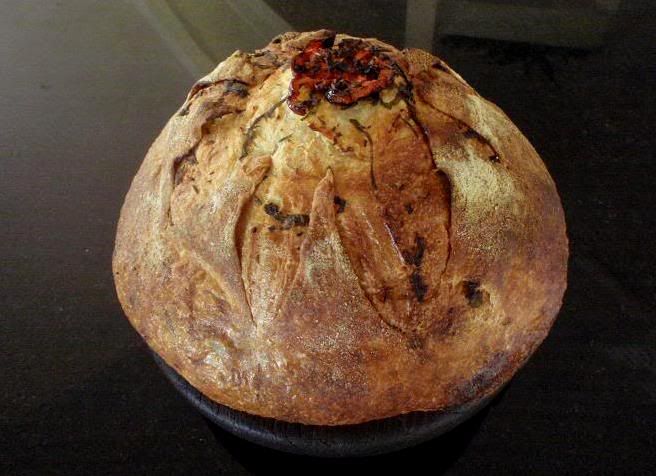
Pain au Levain with Herbs and Tomato
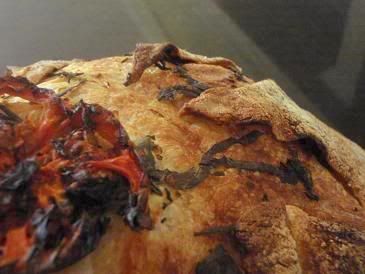
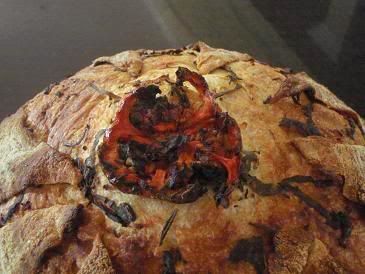
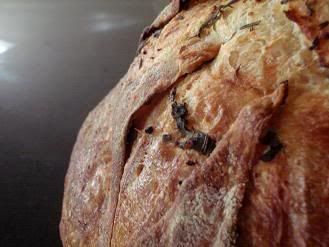
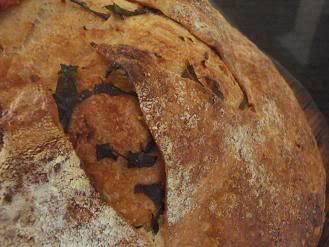
This bread was very satisfying to make. I was surprised at how much oven spring I got and how open the crumb was, considering that this was a 68% hydration dough. What has helped me a lot is the understanding of at what stage I should take the starter to mix my dough. For the pain au levain style of bread that I make, I like to take it as soon as it domes. If it domes but when I touch it, it "shrinks" and flattens, the starter has gone too mature for me. No doubt it can still leaven dough, but I don't think it is at its most rigorous.
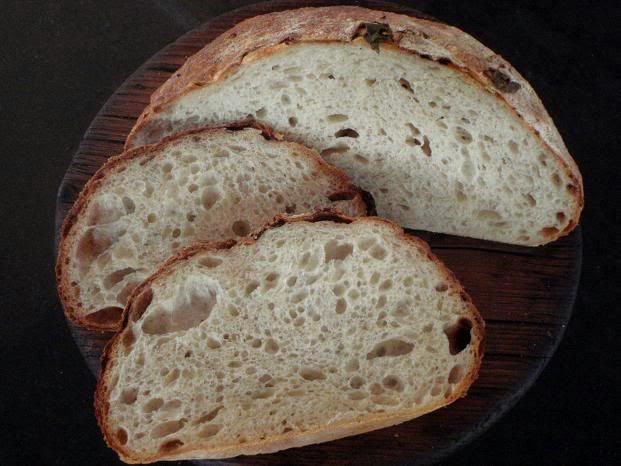

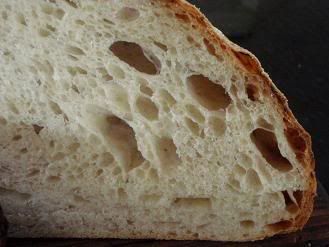
The crumb was beautiful but the lighting at the time when I took the photos did not allow the creaminess in color to show through. (It is a constant battle trying to have enough light but not too much at the same time to do justice for the color of the crumb.) The crumb had a very delicate flavour. The sour tang, while mild, is there. If I were to change anything, however, I would perhaps increase the rye and whole wheat flour components of the dough from 3% and 6%, respectively, to 5% and 10%, or even higher, in which case the hydration may need to be adjusted.
My Formula
for the dough
- 200 g just ripe 75%-hydration starter (30% baker's percentage)
- 25 g medium rye flour (3% of total flour)
- 50 g whole wheat flour (6% of total flour)
- 590 g organic unbleached plain flour
- 444 g water (if you wish, you can substitute 3 tbsp of olive oil and 400 g water; the olive oil will make the crumb really tender)
- 13 g salt
for the herb mixture - or any herbs combination of your choice. Mince the following except the tomato:
- A sprig of rosemary (about 15 cm in length, no more than 20 cm)
- Basil from one stalk
- One clove of garlic (no more, unless you love garlic)
- 2 - 3 very, very thinly sliced ginger
- 2 tbsp of olive oil
- Rock salt
- One slice of tomato (sliced horizontally)
Total dough weight was 1320 g and overall dough hydration was 68%.
Main points of my method
- (1) Mix your dough as normal. (My bulk fermentation was 3 hours and my room temperature at the time was 25 - 26 C. I did 4 sets of stretch and folds of 20 strokes each, no more, over the 3 hours period. When I do my S&F, with each stroke I try to do it gently and slowly so as not to tear the dough.)
- (2) Prepare the herb mixture and put it aside.
- (3) When it is time to divide the dough, section off a piece of dough about 250 grams (or 300 g if you wish) and set it aside.
- (4) Pre-shape and shape the main dough as you would normally for a boule.
- (5) Roll out the small piece of dough to a round disc with a rolling pin or with your hands as if you are making a pizza base.
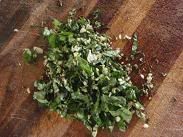

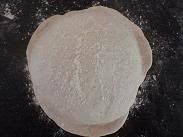
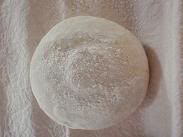
- (far left) the herb mixture
- (centre left) rub the herb mixture over the surface of the main dough and place the piece of tomato over the top
- (centre right) place the small round disc over the dough
- (far right) turn the dough over, tuck in the edges; turn it over again (right side is now up) and lightly tighten the boule (if you try to tighten it too much, the thin layer of dough may break). Place it on a dusted couche or tea towel (right side up) as in the picture.
- (6) Proof for 1/2 hour (no more, because by the time all this pre-shaping and shaping is done, 1/2 to 3/4 of an hour is gone by, and that all adds to the fermentation time). My room temperature was 25 - 26 C, so adjust your fermentation time if your temperature is different.
- (7) Place the boule in the fridge for overnight retarding (from the time I started dividing & shaping to the time my boule was sent to the fridge, it was one hour. I did 15 hours retarding. Anywhere between 8 hours and 24 hours is fine.
- (8) Bake with steam at 230C (no higher as the oil on the inner surface of the dough may burn too quickly if the temperature is too high). I baked it for 40 minutes. (For the last 8 - 10 minutes, I had to drop the temperature to 210C as the crust was already getting good color.)
This levain bread was fun to make, satisfying for my mind and body -

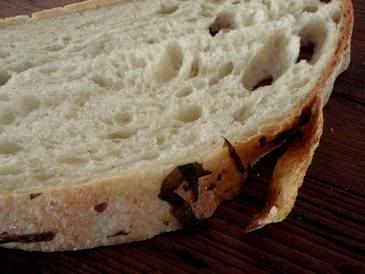
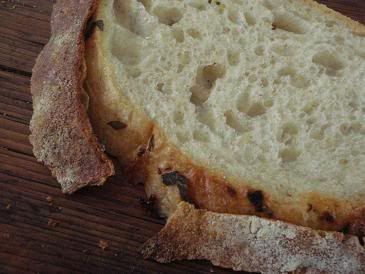
As I was finishing the draft for this post, my husband walked into my tea room with a bottle of Mt Pleasant single vineyard Lovedale 1996 Semillon, his favourite. I decided the fish would have to wait for another night. For now, all that I can manage is this -

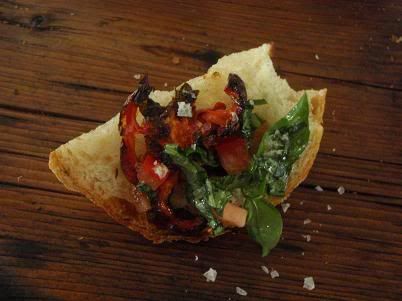
A piece of today's bread with tomato, basil, olive oil, and Margaret River pink rock salt from Western Australia
A satisfying day for my mental and physical indeed.
Shiao-Ping